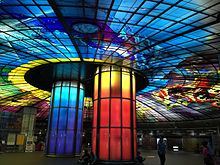Formosa Boulevard Metro Station
The Formosa Boulevard Station is a subway station in Kaohsiung , southern Taiwan . It is a transfer station where the orange and red lines of the Kaohsiung Subway (KMRT) cross. There are 11 exits and entrances in Formosa Boulevard Station. In contrast to other stations, the entrances and exits at this station are designed in the shape of a shell. Barrier-free elevators are available at exits 1 and 3.
The name "Formosa Boulevard Station" refers to the Formosa Boulevard project, a redesign of the main thoroughfare, Zhongshan Road, on which the station is located. The station is also named after the historically significant Kaohsiung incident (in Chinese: Meilidao shijian , "Formosa incident") that took place nearby. The project started with the renovation of Zhongshan Road in preparation for the 2009 World Games .
history
On December 10, 1979, the Kaohsiung incident occurred in the place where Formosa Boulevard Station is now located. The incident changed Taiwanese society and played an important role in the democratization of Taiwan. The name of the station recalls this event. The station's designer is Shin Takamatsu (高 松 伸), a Japanese architect. The station has shell-shaped entrances and exits. The famous glass artwork “Dome of Light” in the station was designed by the Italian artist Narcissus Quagliata . The glass comes from Germany. The light dome was made by a team from Derix-Glasstudio Taunusstein from Germany and the colored glasses of the building were painted by Narcissus Quagliata. The construction time was a total of four and a half years.
The light dome
Idea and design
The light dome was composed of 4,500 colored pieces of glass. Its diameter is 30 meters and the area is 660 square meters. The light dome symbolizes historical commemoration and the pursuit of democracy. The roof is divided into four parts (water, earth, light and fire). They represent birth, development, prosperity and destruction.
The light dome deals with four topics: water, earth, light and fire. In addition to the roof, the two pillars that support the roof also have important meanings. The red column stands for an anode (positive electrode), a symbol of passion, like a volcanic eruption. On the other hand, the blue column means a cathode (negative electrode), a symbol for the blue ocean. Anode and cathode also represent the Chinese principle of yin and yang in Taichi . There are many drawings on the roof, but the drawings are always different, there is no repetition.
Different impressions are created under the roof depending on the perspective. The designer of the light dome Narcissus Quagliata described his concept: “I wanted to convey the idea of humanity to people. The relationship from person to person, from person to nature, and most importantly, from person to everything. When everything on earth comes together there will be neither hatred nor war ”.
Symbols on the roof and their explanation
Water: In the ocean, a woman is hugging the moon. This is the radiant birth of life (women and birth).
Earth: a tolerant man who looks to the sky full of stars (men and wealth)
Fire: A naked, barefoot and barehanded man who combats hatred and conflict. This creates angry fire. Everything died from the fire. The phoenix is reborn from the ashes (destruction and rebirth).
Light: a persistent soul that never gives up
Design of the subway station
| EG | Inputs / outputs | Inputs / outputs (1–11) |
| B1 | Station concourse | The light dome |
| Information desk, ticket machines,
Toilets (near exit 2, 4, 5, 7) |
||
| B2 | Transit zone | Connection with platform 1,
Stairs and escalators to the Orange Line platform |
| Platform 1 | ||
| Platform 2 | ||
| Transit zone | Connection with platform 2,
Stairs and escalators to the Red Line platform |
|
| B3 | Platform 1 | |
| Platform 2 |
Transit zone
- Red line
The first train from Formosa Boulevard (美麗 島) to Gangshan Süd (南岡 山) departs at 05:58 and the first train from Formosa Boulevard to Siaogang (小港) at 06:12.
- Orange line
The first train from Formosa Boulevard to Daliao (大寮) departs at 06:05 and the first train from Formosa Boulevard to Sizihwan (西子 灣) at 06:00.
Bus routes
Bus 12 (from Siaogang (Xiaogang) to Kaohsiung Central Station ): Kaohsiung Airport , Central Park (KMRT) , etc.
Bus 24B (from Nanzi (楠梓) to Yanchengpu (鹽 埕 埔)): Kaohsiung Girls College
Bus 52 (from Jianjun (建軍 站) to Kaohsiung Central Station): Kaohsiung Cultural Center , Central Park , etc.
Bus 60 (from Art Center Pier 2 to Mengli Community Center (夢裡 活動 中心)): Kaohsiung Central Station, National Science and Technology Museum , etc.
Bus 69 (from Siaogang to Kaohsiung Central Station): Kaohsiung National University of Gastronomy and Tourism , Kaohsiung City Government , Central Park , etc.
Bus 72 (from Jinshi Lake to Chung-Cheng Industrial College ): Kaohsiung Main Railway Station, Cultural Center, Guanghua (光華) Night Market, etc.
Figures and data on Formosa Boulevard Station
| year | Number of passengers per day |
| 2013 | 7335 |
| 2014 | 7351 |
| 2015 | 7317 |
| 2016 | 7814 |
Environment of the station
- China Post (Kaohsiung Branch)
- Land bank
- Liuhe night market
- Police station
Web links
- The Dome of Light (English)
- Travel in Taiwan- Kaohsiung City (English)
- Atlas Obscura- The Dome of Light
- Formosa Boulevard Station Map (Chinese)
Individual evidence
- ↑ http://news.ltn.com.tw/news/local/paper/1004631 Formosa Boulevard Project
- ↑ 美麗 島 站 - 光 之 穹頂. Retrieved April 17, 2017 .
- ↑ in-on-at (inonat): 【遊記】 高雄。 捷運 美麗 島 站 光 之 穹頂 ~ 由 創作 人 親自 解說 介紹 的 說明 會 @ in-on-at :: 痞 客 邦 PIXNET :: . In: in-on-at . ( pixnet.net [accessed April 17, 2017]).
- ↑ 交通部 觀光局: 交通部 觀光局 - 高雄市. April 30, 2008. Retrieved April 17, 2017 .
- ↑ 高雄 捷運 股份有限公司: www.krtco.com.tw: 高雄 捷運. Retrieved April 17, 2017 .








